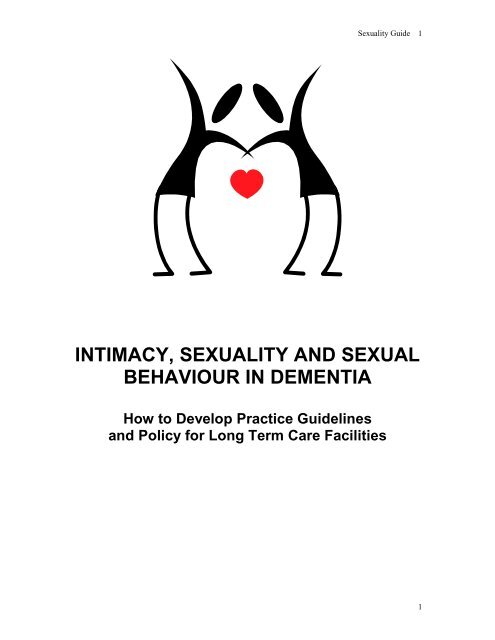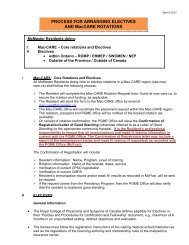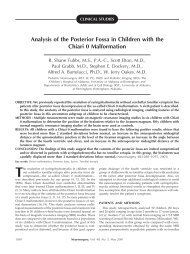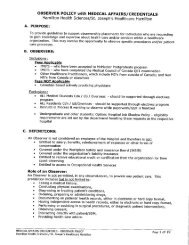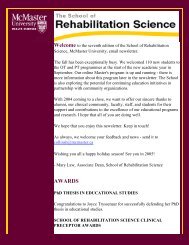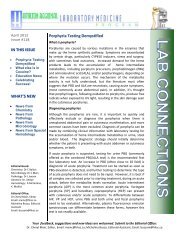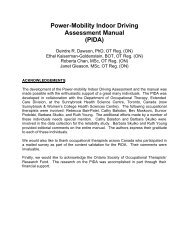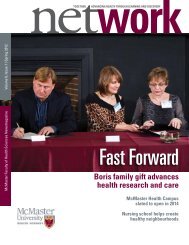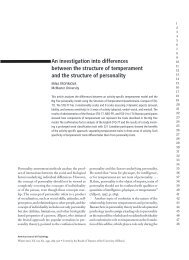Intimacy, Sexuality and Sexual Behavior in Dementia
Intimacy, Sexuality and Sexual Behavior in Dementia
Intimacy, Sexuality and Sexual Behavior in Dementia
You also want an ePaper? Increase the reach of your titles
YUMPU automatically turns print PDFs into web optimized ePapers that Google loves.
<strong><strong>Sexual</strong>ity</strong> Guide 1<br />
INTIMACY, SEXUALITY AND SEXUAL<br />
BEHAVIOUR IN DEMENTIA<br />
How to Develop Practice Guidel<strong>in</strong>es<br />
<strong>and</strong> Policy for Long Term Care Facilities<br />
1
<strong><strong>Sexual</strong>ity</strong> Guide 2<br />
<strong>Intimacy</strong>, <strong><strong>Sexual</strong>ity</strong> <strong>and</strong> <strong>Sexual</strong> Behaviour <strong>in</strong> <strong>Dementia</strong><br />
How to Develop Practice Guidel<strong>in</strong>es <strong>and</strong> Policy for LTC Facilities<br />
Acknowledgment<br />
This document was developed with <strong>in</strong>put from the follow<strong>in</strong>g work<strong>in</strong>g<br />
group members:<br />
Debbie Christie (Organiz<strong>in</strong>g Chair), R.S.W., Macassa Lodge,<br />
Hamilton<br />
Laurie Botham, R.P.N., Blackadar Nurs<strong>in</strong>g Home, Dundas<br />
Sue Gilbert, R.N., The Well<strong>in</strong>gton, Hamilton<br />
Brad Hall, R.N., Macassa Lodge, Hamilton<br />
Lis Latner, Constable, Senior Support Officer, City of Hamilton<br />
Gabriela Luchs<strong>in</strong>ger, R.S.W., St. Joseph’s Healthcare, Hamilton,<br />
Centre for Mounta<strong>in</strong> Health Services<br />
Bonita Miller, R.N., Victoria Gardens, Hamilton<br />
Lori Sch<strong>in</strong>del Mart<strong>in</strong>, (Document Editor), R.N., Ruth Sherman Centre,<br />
Shalom Village, Hamilton<br />
Beth Treen, R.S.W., St. Joseph’s Healthcare, Hamilton, St. Joseph’s<br />
Villa, Dundas<br />
With consultation from Michael Coughl<strong>in</strong>, Ph.D., Ethicist, St. Joseph’s<br />
Healthcare, Hamilton <strong>and</strong>,<br />
Paula Eyles, Cl<strong>in</strong>ical Nurse Specialist, Patient Education, St.<br />
Joseph’s Healthcare, Hamilton.<br />
2
<strong><strong>Sexual</strong>ity</strong> Guide 3<br />
<strong>Intimacy</strong>, <strong><strong>Sexual</strong>ity</strong> <strong>and</strong> <strong>Sexual</strong> Behaviour <strong>in</strong> <strong>Dementia</strong><br />
How to Develop Practice Guidel<strong>in</strong>es <strong>and</strong> Policy for LTC Facilities<br />
Introduction<br />
A group of professionals represent<strong>in</strong>g Long Term Care <strong>in</strong> the<br />
Hamilton region formed as a result of concerns about practice<br />
patterns <strong>in</strong> response to issues of sexuality <strong>and</strong> dementia. Members<br />
<strong>in</strong>cluded representatives from various Long Term Care facilities, a<br />
M<strong>in</strong>istry of Health <strong>and</strong> Long Term Care Advisor, a Police Officer <strong>and</strong><br />
a Psychiatric Social Worker. The purpose of this community wide<br />
<strong>in</strong>itiative was to provide a vehicle for discussion <strong>and</strong> reflection about a<br />
cl<strong>in</strong>ical issue that was somewhat overwhelm<strong>in</strong>g at first glance. The<br />
result<strong>in</strong>g dialogue assisted participants to educate themselves <strong>and</strong><br />
<strong>in</strong>crease their comfort level so that their respective LTC facilities<br />
would be able to develop responsive <strong>and</strong> effective policies regard<strong>in</strong>g<br />
this issue.<br />
The work<strong>in</strong>g group reviewed a variety of policies <strong>and</strong> guidel<strong>in</strong>es from<br />
a number of agencies throughout the prov<strong>in</strong>ce of Ontario. The group<br />
also reviewed the literature on the identification <strong>and</strong> management of<br />
sexual behaviour <strong>in</strong> the face of dementia. This Guide is a compilation<br />
of the knowledge, ideas <strong>and</strong> experiences acquired by the work<strong>in</strong>g<br />
group. The Guide will assist Long Term Care facilities to develop a<br />
resident-oriented policy that will balance resident rights with the<br />
mission <strong>and</strong> goals of their organizations.<br />
3
Why is sexual expression <strong>in</strong> dementia so difficult?<br />
<strong><strong>Sexual</strong>ity</strong> Guide 4<br />
<strong>Intimacy</strong>, sexuality <strong>and</strong> sexual behaviours rema<strong>in</strong> some of the most<br />
sensitive <strong>and</strong> controversial health care issues that arise <strong>in</strong> Long Term<br />
Care facilities. As older persons with dement<strong>in</strong>g illnesses experience<br />
changes <strong>in</strong> cognition <strong>and</strong> judgement, the expression of their sexuality<br />
may result <strong>in</strong> behaviors that are challeng<strong>in</strong>g to manage <strong>in</strong> a<br />
communal environment. Health care professionals work<strong>in</strong>g <strong>in</strong> Long<br />
Term Care facilities often perceive elderly residents with dementia to<br />
be asexual be<strong>in</strong>gs. There is a pervasive belief <strong>in</strong> society that “sex is<br />
for the cognitively <strong>in</strong>tact”. Consequently, it is often difficult for frontl<strong>in</strong>e<br />
workers to accept that residents <strong>and</strong> those co-residents they<br />
identify to be potential partners have the right to seek out <strong>and</strong> engage<br />
<strong>in</strong> sexual expression, <strong>and</strong> be given privacy to carry on <strong>in</strong>timate<br />
relationships (Davies, Zeiss, Shea & T<strong>in</strong>klenberg, 1998).<br />
While some health care professionals may agree that residents with<br />
Alzheimer Disease (AD) have a right to sexual expression, cultural<br />
values, personal beliefs, <strong>and</strong> <strong>in</strong>adequate tra<strong>in</strong><strong>in</strong>g result <strong>in</strong> obstacles to<br />
consistent practice. Some team members may feel that sexual<br />
expression between elderly residents who are demented is a direct<br />
affront to their personal values <strong>and</strong> beliefs. Other members of the<br />
team may support <strong>and</strong> encourage relationships between elderly<br />
residents with dementia (Harris & Wier, 1998). Unfortunately, these<br />
differ<strong>in</strong>g viewpo<strong>in</strong>ts make it difficult for team members to discuss<br />
assessment, management <strong>and</strong> treatment strategies <strong>and</strong> come to a<br />
consensus on how to respond.<br />
There are many reasons why <strong>in</strong>timacy, sexuality <strong>and</strong> sexual<br />
behaviours rema<strong>in</strong> challeng<strong>in</strong>g issues for health care teams <strong>in</strong> Long<br />
Term Care. The issues <strong>in</strong>volved are very complex <strong>and</strong> require<br />
careful <strong>and</strong> detailed assessment. Interpretation of sexual behaviour<br />
<strong>and</strong> relationships takes place with<strong>in</strong> the context of the law, family<br />
belief systems <strong>and</strong> practice st<strong>and</strong>ards (See Figure 1).<br />
4
Figure 1<br />
Issues related to sexuality <strong>in</strong> long term care<br />
Family/Decision-maker<br />
• Values, beliefs<br />
• Comfort level<br />
Family/Decision-maker<br />
• Values, beliefs<br />
• Comfort level<br />
Cl<strong>in</strong>ical<br />
• Assessment<br />
• Ethics<br />
Cl<strong>in</strong>ical<br />
• Assessment<br />
• Ethics<br />
Resident 1<br />
Resident 2<br />
Staff<br />
• St<strong>and</strong>ards<br />
of practice<br />
• Values, beliefs<br />
• Education<br />
Staff<br />
• St<strong>and</strong>ards<br />
of<br />
practice<br />
• Values, beliefs<br />
• Education<br />
<strong><strong>Sexual</strong>ity</strong> Guide 5<br />
Law<br />
• Health Care<br />
Consent Act<br />
<strong>and</strong><br />
Crim<strong>in</strong>al Code<br />
Law<br />
• Health Care<br />
Consent Act<br />
<strong>and</strong><br />
Crim<strong>in</strong>al Code<br />
5
<strong><strong>Sexual</strong>ity</strong> Guide 6<br />
In addition, the topic evokes an awkward emotional response <strong>in</strong><br />
many health care providers; sexual activity of any k<strong>in</strong>d <strong>in</strong> a communal<br />
sett<strong>in</strong>g <strong>and</strong> consensual sex between demented <strong>in</strong>dividuals both raise<br />
many ethical questions. There is also a lack of research <strong>in</strong> the<br />
current literature to guide practice.<br />
Why does the facility need a policy on sexual expression <strong>in</strong><br />
dementia?<br />
The manner <strong>in</strong> which <strong>in</strong>timacy, sexuality <strong>and</strong> sexual behavior will be<br />
<strong>in</strong>terpreted <strong>and</strong> responded to varies greatly between <strong>in</strong>dividual<br />
members of any health care team. Personal beliefs, moral codes <strong>and</strong><br />
cultural attitudes about sexuality may conflict with expected<br />
professional beliefs.<br />
It is essential that Long Term Care facilities develop a policy that<br />
ensures consistency <strong>and</strong> fairness <strong>in</strong> management strategies. In an<br />
actual cl<strong>in</strong>ical situation, the values of residents, family <strong>and</strong> staff may<br />
be <strong>in</strong> conflict. Without a guid<strong>in</strong>g policy, staff <strong>and</strong> family may decide<br />
on a management response that disregards the preferences of the<br />
residents <strong>in</strong>volved. Such a policy will also ensure that residents who<br />
are unable to object will be protected from unwanted sexual<br />
advances.<br />
Some facts about sexual behaviour <strong>and</strong> dementia<br />
• The impact of dementia on sexual behavior is a reduction <strong>in</strong><br />
sexual drive. In fact, sexual apathy is reported <strong>in</strong> 23% of cases<br />
(Miller et al, 1995).<br />
• An <strong>in</strong>crease <strong>in</strong> libido is reported <strong>in</strong> about 14% of those elderly<br />
with dementia (Cumm<strong>in</strong>gs & Victoroff, 1990).<br />
• The <strong>in</strong>cidence of sexually <strong>in</strong>appropriate behaviours <strong>in</strong> persons<br />
with dementia is reported to be very low, rang<strong>in</strong>g from between 2.6%<br />
to 8% with<strong>in</strong> samples of residents diagnosed with Alzheimer’s<br />
Disease (Harris & Wier, 1998).<br />
For other facts about sexual expression <strong>and</strong> dementia please review<br />
the articles located <strong>in</strong> the bibliography (Appendix A).<br />
6
How to use this guide<br />
<strong><strong>Sexual</strong>ity</strong> Guide 7<br />
The guide has been designed as a resource to use as the facility<br />
develops its own policy guidel<strong>in</strong>es. It <strong>in</strong>cludes:<br />
• Steps outl<strong>in</strong><strong>in</strong>g policy development<br />
• List<strong>in</strong>g of facilities <strong>and</strong> resources to contact<br />
• Extensive bibliographic <strong>in</strong>formation<br />
• Worksheet to assist team to discuss cl<strong>in</strong>ical cases<br />
Steps to develop a policy<br />
Step 1 - Assemble a team:<br />
Assemble a group of key stakeholders that should be <strong>in</strong>volved <strong>in</strong><br />
develop<strong>in</strong>g the policy. Ask for volunteers from the list of key players<br />
listed below. Front-l<strong>in</strong>e workers must be <strong>in</strong>cluded <strong>in</strong> the development<br />
process. Staff members who are not able to participate need to be<br />
kept <strong>in</strong>formed of the process <strong>and</strong> be asked to provide <strong>in</strong>put to<br />
revisions of the draft policy. Key players that may be <strong>in</strong>volved <strong>in</strong> the<br />
process <strong>in</strong>clude:<br />
Health Care Aide/Personal Support Worker<br />
Nutrition Services<br />
Housekeep<strong>in</strong>g<br />
Registered Practical Nurse<br />
Registered Nurse<br />
Social Worker<br />
Recreational Therapy<br />
Physiotherapist<br />
Physician<br />
Family<br />
Adm<strong>in</strong>istrator<br />
Board Representative<br />
Pastoral Care/Chapla<strong>in</strong> Services/Spiritual Care<br />
Volunteer Coord<strong>in</strong>ator<br />
7
<strong><strong>Sexual</strong>ity</strong> Guide 8<br />
The facility may wish to <strong>in</strong>clude an ethicist <strong>in</strong> the policy development<br />
process if one is available.<br />
Step 2 – Learn about the issues<br />
It is important that all members of the team read some of the<br />
pert<strong>in</strong>ent articles listed <strong>in</strong> the bibliography. This helps participants<br />
remove themselves from their own pre-exist<strong>in</strong>g beliefs <strong>and</strong> biases<br />
about sexuality <strong>and</strong> sexual behaviors <strong>in</strong> demented elderly. The team<br />
members should discuss pert<strong>in</strong>ent issues that arise from the literature<br />
review. An experienced facilitator may help the group work through<br />
this.<br />
Step 3 - Consider conduct<strong>in</strong>g focus groups<br />
Initial focus groups should concentrate on values clarification<br />
exercises <strong>and</strong> a discussion of the literature reviewed <strong>in</strong> Step 2. This<br />
should <strong>in</strong>volve as many team members as the facility’s personnel<br />
resources allow. The facility’s work<strong>in</strong>g group members may act as<br />
facilitators for the focus groups. It is important that <strong>in</strong>dividual staff<br />
members be encouraged to discuss their values, beliefs <strong>and</strong> personal<br />
moral codes <strong>and</strong> how these may conflict with their stated professional<br />
position. Focus groups will also facilitate discussion around issues<br />
such as consent <strong>and</strong> risk assessment. It will assist each unique<br />
facility to identify the organizational comfort zone <strong>and</strong> barometer<br />
through which normal behaviour, acceptable behaviour <strong>and</strong><br />
pathological behaviour will be identified.<br />
Step 4 – Review sample policies from other organizations<br />
Contact other Long Term Care organizations to review their policies<br />
(Appendix B). Facilities with<strong>in</strong> a specific geographical area may be<br />
able to work together to develop a regional policy. Individual<br />
organizations can use features from each policy to build practice<br />
guidel<strong>in</strong>es that will best match their own organization’s philosophy<br />
<strong>and</strong> mission statement.<br />
8
<strong><strong>Sexual</strong>ity</strong> Guide 9<br />
Step 5 – Create work<strong>in</strong>g def<strong>in</strong>itions of key concepts <strong>in</strong> the policy<br />
Def<strong>in</strong>e: • sexuality, <strong>in</strong>timacy <strong>and</strong> sexual behaviour<br />
• sexual behaviours to be <strong>in</strong>terpreted as normal<br />
• sexual behaviours requir<strong>in</strong>g assessment<br />
• sexual behaviours of concern/risk (Sloane, 1993).<br />
The facility may want to <strong>in</strong>clude their viewpo<strong>in</strong>t of relationships<br />
between residents of the same gender. If a facility has a specific<br />
cultural or religious affiliation, the policy needs to reflect those<br />
<strong>in</strong>herent values.<br />
In addition, the facility needs to develop work<strong>in</strong>g def<strong>in</strong>itions of<br />
consent related to sexual behaviour <strong>and</strong> relationships. Lichtenberg<br />
(1997) <strong>and</strong> Lichtenberg <strong>and</strong> Strzepek (1990) suggest that the<br />
follow<strong>in</strong>g questions should be asked to identify under what conditions<br />
<strong>and</strong> circumstances a relationship between co-residents should be<br />
allowed <strong>and</strong>/or encouraged to cont<strong>in</strong>ue.<br />
1. Resident’s awareness of the relationship<br />
a. Is the resident aware of who is <strong>in</strong>itiat<strong>in</strong>g sexual contact?<br />
b. Does the resident believe that the other person is a spouse<br />
<strong>and</strong> thus acquiesce out of a delusional belief, or are they<br />
cognizant of the other’s identity <strong>and</strong> <strong>in</strong>tent?<br />
c. Can the resident state what level of sexual <strong>in</strong>timacy they<br />
would be comfortable with?<br />
2. Resident’s ability to avoid exploitation<br />
a. Is the behaviour consistent with formerly held<br />
beliefs/values?<br />
b. Does the resident have the capacity to say no to any<br />
un<strong>in</strong>vited sexual contact?<br />
3. Resident’s awareness of potential risks<br />
a. Does the resident realize that this relationship may be time<br />
limited (placement on unit is temporary)?<br />
b. Can the resident describe how they will react when the<br />
relationship ends?<br />
9
<strong><strong>Sexual</strong>ity</strong> Guide 10<br />
Lichtenberg (1997) has developed a prelim<strong>in</strong>ary decision-tree that<br />
may help the organization:<br />
Decision Tree for Assess<strong>in</strong>g Competency to Participate<br />
<strong>in</strong> an Intimate Relationship<br />
M<strong>in</strong>i-Mental State score greater than 14<br />
Yes No<br />
Perform assessment Patient unable to consent<br />
<strong>in</strong>terview<br />
Patient’s ability to avoid exploitation<br />
Yes No<br />
Cont<strong>in</strong>ue Patient unable to consent<br />
evaluation<br />
Patient’s awareness of the relationship<br />
Yes No<br />
Cont<strong>in</strong>ue Patient unable to consent<br />
evaluation<br />
Patient’s awareness of risk<br />
Yes No<br />
Consider patient Provide frequent<br />
competent to rem<strong>in</strong>ders of risk<br />
participate <strong>in</strong> an but permit<br />
<strong>in</strong>timate relationship relationship<br />
Lichtenberg (1997)<br />
10
<strong><strong>Sexual</strong>ity</strong> Guide 11<br />
Lichtenberg’s (1997) ideas may prove helpful as to develop the<br />
policy. However, it may be necessary to make some adjustments to<br />
the decision-tree. For example, a St<strong>and</strong>ardized M<strong>in</strong>i-Mental State<br />
Exam<strong>in</strong>ation (SMMSE; Molloy, Alemayehu & Roberts, 1991) score of<br />
14 may be too limit<strong>in</strong>g when assess<strong>in</strong>g competency <strong>in</strong> this context.<br />
Many residents with lower SMMSE scores <strong>in</strong> fact, may have an<br />
awareness of the relationship, be able to avoid exploitation, <strong>and</strong> give<br />
an account of risks of the relationship. Therefore, it may be<br />
unreasonable to forbid the relationship on the basis of an SMMSE<br />
score alone.<br />
Step 6 – Identify <strong>in</strong>terventions<br />
It is important that the policy <strong>in</strong>clude a list of <strong>in</strong>terventions that clearly<br />
outl<strong>in</strong>e expectations regard<strong>in</strong>g how staff will respond. For example,<br />
encourag<strong>in</strong>g non-sexual forms of physical <strong>in</strong>timacy such as hugg<strong>in</strong>g,<br />
hold<strong>in</strong>g h<strong>and</strong>s <strong>and</strong> danc<strong>in</strong>g. Initiate environmental <strong>and</strong> behavioural<br />
<strong>in</strong>terventions as a first-l<strong>in</strong>e treatment response <strong>in</strong> the absence of<br />
high-risk behaviour. Persistent hyper-sexuality that presents high risk<br />
of physical <strong>in</strong>jury to co-residents would be the cl<strong>in</strong>ical <strong>in</strong>dicator for<br />
discuss<strong>in</strong>g the <strong>in</strong>itiation of antilibid<strong>in</strong>al hormones. Without this<br />
<strong>in</strong>dicator, the <strong>in</strong>troduction of medication as a management response<br />
is not prudent practice (Kuhn, Gre<strong>in</strong>er & Arseneau, 1998).<br />
Step 7 – Draft a work<strong>in</strong>g policy document<br />
The policy is now ready to be developed. Ensure that the policy<br />
def<strong>in</strong>es consent <strong>and</strong> risk. A specific reference to sexual expression<br />
should be <strong>in</strong> the mission statement. Consider the follow<strong>in</strong>g dist<strong>in</strong>ct<br />
issues <strong>and</strong> where they might fit <strong>in</strong>to the policy, with focus on the<br />
specific expectations for staff professional practice:<br />
• Assessment procedure to be followed to determ<strong>in</strong>e level<br />
of risk associated with any sexual behaviour, <strong>in</strong>clud<strong>in</strong>g the<br />
implementation of any assessment tools <strong>and</strong> tak<strong>in</strong>g a sexual history<br />
upon admission. An example is the P.I.E.C.E.S. Manual for<br />
assessment guidel<strong>in</strong>es that many facilities have.<br />
• Report<strong>in</strong>g procedure of observed sexual behaviours,<br />
<strong>in</strong>clud<strong>in</strong>g <strong>in</strong>form<strong>in</strong>g families.<br />
11
<strong><strong>Sexual</strong>ity</strong> Guide 12<br />
• Documentation procedures, appropriate term<strong>in</strong>ology to be<br />
used with objective observations recorded, not personal values<br />
statements. The documentation system should support notations that<br />
explicate the frequency, <strong>in</strong>tensity, duration <strong>and</strong> level of risk<br />
associated with observed sexual behaviours.<br />
• Team discussion/meet<strong>in</strong>g expectations to review the<br />
parameters of sexual behaviours <strong>in</strong> each cl<strong>in</strong>ical case, <strong>and</strong> to identify,<br />
implement <strong>and</strong> evaluate <strong>in</strong>terventions. Remember that<br />
family/Substitute decision makers/Power of attorney’s <strong>in</strong>volvement <strong>in</strong><br />
team meet<strong>in</strong>gs <strong>and</strong> decision-mak<strong>in</strong>g is crucial to good practice. A<br />
sample team discussion worksheet can be found <strong>in</strong> Appendix C.<br />
• Reference to when police <strong>in</strong>volvement might be deemed<br />
necessary accord<strong>in</strong>g to the M<strong>in</strong>istry of Health <strong>and</strong> Long Term Care’s<br />
report<strong>in</strong>g requirements for unusual occurrence <strong>in</strong>cidents. For<br />
example, extreme circumstances such as serious physical <strong>in</strong>jury<br />
requir<strong>in</strong>g hospitalization would warrant police consultation.<br />
• Consider hav<strong>in</strong>g a decision-tree that helps staff identify<br />
management responses to sexual behaviors.<br />
• Educational tra<strong>in</strong><strong>in</strong>g for staff (expectations of<br />
participation).<br />
• Outl<strong>in</strong>e the organization’s commitment <strong>and</strong> <strong>in</strong>tent for<br />
ongo<strong>in</strong>g staff tra<strong>in</strong><strong>in</strong>g <strong>and</strong> orientation, <strong>and</strong> orientation of new families<br />
to the facility’s policy.<br />
• Include case studies as an addendum to the policy that<br />
can be used for orientation of new staff.<br />
Step 8 - Implement the policy<br />
Circulate the policy as a draft. Have staff members <strong>in</strong>volved <strong>in</strong><br />
prelim<strong>in</strong>ary focus groups exam<strong>in</strong>e the draft policy <strong>and</strong> give feedback.<br />
It would be helpful to <strong>in</strong>volve the Resident’s Council at this po<strong>in</strong>t. If<br />
family members were not <strong>in</strong>volved <strong>in</strong> the work<strong>in</strong>g group, then it may<br />
12
<strong><strong>Sexual</strong>ity</strong> Guide 13<br />
be prudent to have their <strong>in</strong>put at this po<strong>in</strong>t <strong>in</strong> the development of the<br />
policy.<br />
Once the policy is f<strong>in</strong>alized, circulate it to staff <strong>and</strong> update them about<br />
the policy <strong>and</strong> its implications for their practice. Have staff meet<strong>in</strong>gs<br />
to <strong>in</strong>troduce the f<strong>in</strong>al version of the policy. Consider hav<strong>in</strong>g a sexual<br />
awareness day/week for staff to review policy on an annual basis.<br />
Have a guest speaker who can talk about this issue come to the<br />
facility as part of an educational <strong>in</strong>itiative attached to this awareness<br />
week. Show a videotape to promote discussion about sexual<br />
behaviour <strong>in</strong> the nurs<strong>in</strong>g home <strong>and</strong> how the policy helps determ<strong>in</strong>e<br />
the appropriate management response. Some suggestions are<br />
<strong>in</strong>cluded <strong>in</strong> the bibliography, Appendix A. The videotapes, available<br />
through local Alzheimer Society resource libraries often <strong>in</strong>clude<br />
discussion guides to help plan educational events. Consider hav<strong>in</strong>g<br />
role-plays with staff dur<strong>in</strong>g team meet<strong>in</strong>gs that would help them learn<br />
appropriate responses to sensitive situations. For additional<br />
suggestions for educational sessions, see Appendix D <strong>and</strong> E.<br />
Step 9 - Evaluate the policy<br />
The policy will most likely be a work <strong>in</strong> progress. It will be important<br />
to set up feedback mechanisms that will help revise the policy. When<br />
sexual behaviour is observed <strong>and</strong> reported, a meet<strong>in</strong>g of the cl<strong>in</strong>ical<br />
team may assist to make the necessary adjustments to help the<br />
policy evolve <strong>in</strong>to a work<strong>in</strong>g document that is practical <strong>and</strong> useful.<br />
The team should review the literature periodically, revis<strong>in</strong>g the policy<br />
to reflect the current underst<strong>and</strong><strong>in</strong>g of sexual behaviour <strong>in</strong> dementia<br />
every two years.<br />
Draft September 7, 11, 2001<br />
November 25, 26, 28, 30, 2001<br />
December 3, 5, 2001<br />
March 14, 19, 2002<br />
13
Key articles <strong>and</strong> book chapters<br />
Appendix A<br />
Reference List<br />
<strong><strong>Sexual</strong>ity</strong> Guide 14<br />
Ballard, E. L. (1995). Attitudes, myths, <strong>and</strong> realities: Help<strong>in</strong>g family <strong>and</strong><br />
professional caregivers cope with sexuality <strong>in</strong> the alzheimer's patient. <strong><strong>Sexual</strong>ity</strong><br />
<strong>and</strong> Disability, 13, 255-270.<br />
Ballard, E. L. (1996). Another side of caregiv<strong>in</strong>g: Address<strong>in</strong>g the <strong>in</strong>timacy<br />
needs of the nurs<strong>in</strong>g home resident with dementia. The Caregiver, Summer, 14-<br />
16.<br />
Ballard, E. L. (1998). <strong><strong>Sexual</strong>ity</strong>, <strong>in</strong>timacy, <strong>and</strong> mean<strong>in</strong>gful relationships <strong>in</strong><br />
the nurs<strong>in</strong>g facility. In M.Kaplan & S.Hoffman (Eds.), <strong>Behavior</strong>s <strong>in</strong> dementia:<br />
Best practices for successful management (pp. 239-253). W<strong>in</strong>nipeg: Health<br />
Professions Press.<br />
Barnes, I. (2001). <strong><strong>Sexual</strong>ity</strong> <strong>and</strong> cognitive impairment <strong>in</strong> long-term care.<br />
Canadian Nurs<strong>in</strong>g Home, 12(3), 5-12.<br />
Hellen, C. R. (1995). <strong>Intimacy</strong>: Nurs<strong>in</strong>g home resident issues <strong>and</strong> staff<br />
tra<strong>in</strong><strong>in</strong>g. American Journal of Alzheimer's Disease, March/April, 12-17.<br />
Janes, N. (2000). Promot<strong>in</strong>g sexual health for residents with cognitive<br />
impairment: The f<strong>in</strong>al frontier <strong>in</strong> long term care. Long Term Care,<br />
November/December, 27-31.<br />
Kuhn, D. (1994). The chang<strong>in</strong>g face of sexual <strong>in</strong>timacy <strong>in</strong> Alzheimer's<br />
disease. The American Journal of Alzheimer's Care <strong>and</strong> Related Disorders &<br />
Research, September/October, 7-14.<br />
Kuhn, D., Gre<strong>in</strong>er, D., & Arseneau, L. (1998). Address<strong>in</strong>g hypersexuality<strong>in</strong><br />
Alzheimer's disease. Journal of Gerontological Nurs<strong>in</strong>g, April, 44-50.<br />
Philo, S. W., Richie, M. F., & Kaas, M. J. (1996). Inappropriate sexual<br />
behavior. Journal of Gerontological Nurs<strong>in</strong>g, 22, 17-22.<br />
Sloane, P. (1993). <strong>Sexual</strong> behavior <strong>in</strong> residents with dementia.<br />
Contemporary Long Term Care, October, 66, 69, 108.<br />
14
Prevalence <strong>and</strong> etiology of sexual behaviours <strong>in</strong> dementia<br />
<strong><strong>Sexual</strong>ity</strong> Guide 15<br />
Burns, A., Jacoby, R., & Levy, R. (1990). Psychiatric phenomena <strong>in</strong><br />
Alzheimer's disease. British Journal of Psychiatry, 157, 86-94.<br />
Cumm<strong>in</strong>gs, J. & Victoroff, J. (1990). Noncognitive neuropsychiatric<br />
syndromes <strong>in</strong> Alzheimer's disease. Neuropsychiatry, Neuropsychology, <strong>and</strong><br />
<strong>Behavior</strong>al Neurology, 3, 140-158.<br />
Cumm<strong>in</strong>gs, J. L. (1996). Neuropsychiatric assessment <strong>and</strong> <strong>in</strong>tervention <strong>in</strong><br />
alzheimer's disease. International Psychogeriatrics, 8, 25-30.<br />
Davies, H., Zeiss, A., & T<strong>in</strong>klenberg, J. (1992). 'Til death do us part:<br />
<strong>Intimacy</strong> <strong>and</strong> sexuality <strong>in</strong> the marriages of alzheimer's patients. Journal of<br />
Psychosocial Nurs<strong>in</strong>g, 30.<br />
Devan<strong>and</strong>, D. P., Brock<strong>in</strong>gton, C. D., Moody, B. J., Brown, R. P., Mayeux,<br />
R., Endicott, J., & Sakeim, H. (1992). <strong>Behavior</strong>al syndromes <strong>in</strong> alzheimer's<br />
disease. International Psychogeriatrics, 4, 161-184.<br />
Haddad, P. M. & Benbow, S. M. (1993). <strong>Sexual</strong> problems associated with<br />
dementia: Problems <strong>and</strong> their consequences. International Journal of Geriatric<br />
Psychiatry, 8, 547-551.<br />
Haddad, P. M. & Benbow, S. M. (1993). <strong>Sexual</strong> problems associated with<br />
dementia: Aetiology, assessment <strong>and</strong> treatment. International Journal of<br />
Geriatric Psychiatry, 8, 631-637.<br />
Miller, B., Darby, A., Yener, G., & Mena, I. (1995). Dietary changes,<br />
compulsions <strong>and</strong> sexual behavior <strong>in</strong> fronto-temporal degeneration. <strong>Dementia</strong>, 6,<br />
195-199.<br />
Research<br />
Alexopoulous, P. (1994). Management of sexually dis<strong>in</strong>hibited behavior<br />
by a dementia patient. Australian Journal on Age<strong>in</strong>g, 13, 119.<br />
Archibald, C. (1998). <strong><strong>Sexual</strong>ity</strong>, dementia <strong>and</strong> residential care: Managers<br />
report <strong>and</strong> response. Health <strong>and</strong> Social Care <strong>in</strong> the Community, 6, 95-101.<br />
Dupras, A. & Poissant, M.-S. (1987). The fear of sexuality <strong>in</strong> residents of a<br />
long-term care hospital. <strong><strong>Sexual</strong>ity</strong> <strong>and</strong> Disability, 8, 203-215.<br />
15
<strong><strong>Sexual</strong>ity</strong> Guide 16<br />
Ehrenfeld, M., Tabak, N., Bronner, G., & Bergman, R. (1997). Ethical<br />
dilemmas concern<strong>in</strong>g sexuality of elderly patients suffer<strong>in</strong>g from dementia.<br />
International Journal of Nurs<strong>in</strong>g Practice, 3, 255-259.<br />
Ehrenfeld, M., Bronner, G., Tabak, N., Alpert, R., Bergman, R., & . (1999).<br />
<strong><strong>Sexual</strong>ity</strong> among <strong>in</strong>stitutionalized elderly patients with dementia. Nurs<strong>in</strong>g Ethics,<br />
6, 144-149.<br />
Harris, L. & Wier, M. (1998). Inappropriate sexual behavior <strong>in</strong> dementia: A<br />
review of the treatment literature. <strong><strong>Sexual</strong>ity</strong> <strong>and</strong> Disability, 16, 205-217.<br />
Kyomen, H., Satl<strong>in</strong>, A., Hennen, J., & Wei, J. (1999). Estrogen therapy<br />
<strong>and</strong> aggressive behavior <strong>in</strong> elderly patients with moderate-to-severe dementia:<br />
Results from a short-term r<strong>and</strong>omized, double-bl<strong>in</strong>d trial. Am J Geriatr<br />
Psychiatry, 7, 339-348.<br />
Livni, M. D. (1994). Nurses' attitudes toward sexuality <strong>and</strong> dementia.<br />
American Journal of Geriatric Psychiatry, 2, 338-345.<br />
Mattiasson, A.-C. & Hemberg, M. (1998). <strong>Intimacy</strong> - Meet<strong>in</strong>g needs <strong>and</strong><br />
respect<strong>in</strong>g privacy <strong>in</strong> the care of elderly people: What is a good moral attitude on<br />
the part of the nurse/carer? Nurs<strong>in</strong>g Ethics, 5, 527-534.<br />
Zeiss, A., Davies, H. D., & T<strong>in</strong>klenberg, J. R. (1996). An observational<br />
study of sexual behavior <strong>in</strong> demented male patients. Journal of Gerontology:<br />
Medical Sciences, 51A, M325-M329.<br />
Assessment<br />
Lichtenberg, P. & Strzepek, D. (1990). Assessments of <strong>in</strong>stitutionalized<br />
dementia patients' competencies to participate <strong>in</strong> <strong>in</strong>timate relationships.<br />
Gerontologist, 30, 117-120.<br />
Lichtenberg, P. A. (1997). Cl<strong>in</strong>ical perspectives on sexual issues <strong>in</strong><br />
nurs<strong>in</strong>g homes. Top Geriatr Rehabil, 12, 1-10.<br />
Molloy, D.W., Alemayehu, E., & Roberts, R. (1991). A st<strong>and</strong>ardized m<strong>in</strong>imental<br />
state exam<strong>in</strong>ation SMSSE. The American Journal of Psychiatry, 148,<br />
102-105.<br />
General read<strong>in</strong>g<br />
Alzheimer Association of NSW (1999). Recognition <strong>and</strong> support for<br />
<strong>in</strong>timacy <strong>and</strong> sexuality issues: What is <strong>in</strong>timacy <strong>and</strong> how is it affected by<br />
dementia? Geriaction, 17, 21-21.<br />
16
<strong><strong>Sexual</strong>ity</strong> Guide 17<br />
Bonifazi, W. (2000). Somebody to love. Contemporary Long Term Care,<br />
April, 22-28.<br />
Bonifazi, W. (2000). Keep<strong>in</strong>g company: <strong>Intimacy</strong> <strong>in</strong> LTC dem<strong>and</strong>s<br />
sensitivity by staff. Ag<strong>in</strong>g Today, 21, 9-11.<br />
Feil, N. (1995). When feel<strong>in</strong>gs become <strong>in</strong>cont<strong>in</strong>ent: <strong>Sexual</strong> behaviors <strong>in</strong><br />
the resolution phase of life. <strong><strong>Sexual</strong>ity</strong> <strong>and</strong> Disability, 13, 271-282.<br />
Kaplan, L. (1996). <strong>Sexual</strong> <strong>and</strong> <strong>in</strong>stitutional issues when one spouse<br />
resides <strong>in</strong> the community <strong>and</strong> the other lives <strong>in</strong> a nurs<strong>in</strong>g home. <strong><strong>Sexual</strong>ity</strong> <strong>and</strong><br />
Disability, 14, 281-293.<br />
Mayers, K. & McBride, D. (1998). <strong><strong>Sexual</strong>ity</strong> tra<strong>in</strong><strong>in</strong>g for caretakers of<br />
geriatric residents <strong>in</strong> long term care facilities. <strong><strong>Sexual</strong>ity</strong> <strong>and</strong> Disability, 16, 227-<br />
236.<br />
Mayers, K. & Solberg, C. (1994). Inappropriate social <strong>and</strong> sexual<br />
responses to a female student by male patients with dementia <strong>and</strong> organic bra<strong>in</strong><br />
disorder. <strong><strong>Sexual</strong>ity</strong> <strong>and</strong> Disability, 12, 207-211.<br />
Mayers, K. (1994). <strong><strong>Sexual</strong>ity</strong> <strong>and</strong> the patient with dementia. <strong><strong>Sexual</strong>ity</strong> <strong>and</strong><br />
Disability, 12, 213-218.<br />
Mayers, K. (1998). <strong><strong>Sexual</strong>ity</strong> <strong>and</strong> the demented patient. <strong><strong>Sexual</strong>ity</strong> <strong>and</strong><br />
Disability, 16, 219-225.<br />
Mayers, K. (2000). Inappropriate social <strong>and</strong> sexual responses to a female<br />
student by male patients with dementia <strong>and</strong> organic bra<strong>in</strong> disorder. <strong><strong>Sexual</strong>ity</strong> <strong>and</strong><br />
Disability, 18, 143-147.<br />
Post, S. G. (2001). An ethics of love for persons with alzheimer's disease.<br />
Alzheimer's Care Quarterly, 2, 23-30.<br />
Rothman, B. & Sebastian, H. (1990). <strong>Intimacy</strong> <strong>and</strong> cognitively impaired<br />
elders. Canadian Nurse, 86, 32-34.<br />
Tunstull, P. & Henry, M. (1996). Approaches to resident sexuality. Journal<br />
of Gerontological Nurs<strong>in</strong>g, 22, 37-42.<br />
Wells, C. G. (1993). Speak<strong>in</strong>g of sex. American Journal of Nurs<strong>in</strong>g, 90.<br />
Videotape Resources<br />
“A Thous<strong>and</strong> Tomorrows”. Produced by Daniel Kuhn. Distributed by<br />
Terra Nova Films. Contact number: 773-881-8491; www.terranova.org<br />
17
<strong><strong>Sexual</strong>ity</strong> Guide 18<br />
“The Heart has No Wr<strong>in</strong>kles”. Produced by Health Media, New South<br />
Wales, Australia. Distributed by: K<strong>in</strong>etic Inc. Contact number: 416-963-5979<br />
“Freedom of <strong>Sexual</strong> Expression: <strong>Dementia</strong> <strong>and</strong> Resident Rights <strong>in</strong> Long-<br />
Term Care Facilities”. Produced by National Alzheimer Center of The Hebrew<br />
Home for the Aged At Riverdale. Distributed by Terra Nova Films. Contact<br />
number: 773-881-8491 or www@terravnova.org<br />
18
Appendix B<br />
Agency Contacts for Practice Guidel<strong>in</strong>es/Policy<br />
<strong><strong>Sexual</strong>ity</strong> Guide 19<br />
Review<strong>in</strong>g examples of policies from other organizations may assist a<br />
facility to develop practice guidel<strong>in</strong>es. It is recommended that<br />
facilities undertak<strong>in</strong>g the development of practice guidel<strong>in</strong>es use the<br />
policy of other organizations only as samples. The work<strong>in</strong>g group<br />
who developed this Guide do not advocate the use of any one policy<br />
over the others <strong>in</strong>cluded <strong>in</strong> the list below. Staff members <strong>in</strong> a facility<br />
are more likely to adopt practices recommended <strong>in</strong> a policy if they<br />
have been <strong>in</strong>volved <strong>in</strong> the development of practice guidel<strong>in</strong>es with<strong>in</strong><br />
their own organization.<br />
Lori Sch<strong>in</strong>del Mart<strong>in</strong><br />
Director, Ruth Sherman Centre for Research <strong>and</strong> Education<br />
Shalom Village Nurs<strong>in</strong>g Home<br />
60/70 Mackl<strong>in</strong> Street North<br />
Hamilton, Ontario<br />
L8S 3S1<br />
Phone: 905-529-1613, ext. 228<br />
lori@shalomvillage.on.ca<br />
Contact for <strong>in</strong>formation on sexual behaviour practice guidel<strong>in</strong>es,<br />
sample policy <strong>and</strong> questions about articles <strong>in</strong> the bibliography<br />
Dr. Maggie Gibson<br />
Psychologist, Veterans Care Program<br />
Parkwood Hospital, St. Joseph’s Health Care London<br />
801 Commissioners Road East<br />
London, Ontario N6C 5J1<br />
Phone: 519-685-4292, ext. 42708<br />
Fax: 519-685-4031<br />
Email: maggie.gibson@sjhc.london.on.ca<br />
Contact for <strong>in</strong>formation on practice change <strong>and</strong> models of care<br />
delivery for behavior associated with dementia <strong>and</strong> literature on<br />
sexual behaviour<br />
19
<strong><strong>Sexual</strong>ity</strong> Guide 20<br />
Beth Treen, R.S.W.<br />
Social Worker<br />
St. Joseph’s Villa<br />
56 Governor’s Road<br />
Dundas, Ontario<br />
L9H 5G7<br />
Phone: 905-627-3541, ext. 2241<br />
Email: btreen@sjv.on.ca<br />
Contact for <strong>in</strong>formation on a decision-mak<strong>in</strong>g flowsheet for sexual<br />
behaviour<br />
Brad Hall, RN<br />
Adm<strong>in</strong>istrator<br />
Macassa Lodge<br />
701 Upper Sherman<br />
Hamilton, Ontario<br />
L8M 3M7<br />
Phone: 905-546-2800<br />
Email: bhall@city.hamilton.on.ca<br />
Contact for <strong>in</strong>formation on <strong>in</strong>timacy <strong>and</strong> sexuality guidel<strong>in</strong>es, <strong>in</strong>clud<strong>in</strong>g<br />
a decision-mak<strong>in</strong>g tree for management of sexuality, guidel<strong>in</strong>es<br />
number NM-04-01-02 (<strong>in</strong> nurs<strong>in</strong>g manual)<br />
L<strong>in</strong>da Jackson, MSW, RSW<br />
Director of Social Work<br />
Baycrest Centre for Geriatric Care<br />
Phone: 416-785-2500, ext. 2434<br />
Email: LJackson@baycrest.org<br />
Contact for <strong>in</strong>formation on abuse policies that also discuss sexual<br />
behavior, policy numbers, VI-130, VI-132, VI-133<br />
Tricia Stiles<br />
Cl<strong>in</strong>ical Specialist<br />
Homewood Health Centre<br />
Guelph, Ontario<br />
Phone: 519-824-1010<br />
Contact for <strong>in</strong>formation on sexual behaviour policy<br />
20
C<strong>in</strong>dy Mart<strong>in</strong><br />
Recreation Therapist<br />
Providence Centre<br />
Scarborough, Ontario<br />
Phone: 416-285-3666<br />
Contact for <strong>in</strong>formation on sexuality guidel<strong>in</strong>es for staff, policy<br />
number: VII-40<br />
<strong><strong>Sexual</strong>ity</strong> Guide 21<br />
Meg Reich<br />
Program Manager<br />
W<strong>in</strong>dsor Essex Geriatric Assessment Program (GAP)<br />
W<strong>in</strong>dsor Regional Hospital<br />
1453 Pr<strong>in</strong>ce Road<br />
W<strong>in</strong>dsor, Ontario<br />
N9C 3Z4<br />
Contact for workbook “<strong>Intimacy</strong> <strong>and</strong> sexuality <strong>in</strong> long term care<br />
facilities” April 1999, developed by W<strong>in</strong>dsor Geriatric<br />
Assessment/Consultation Program, conta<strong>in</strong>s a sample policy, <strong>and</strong><br />
decision-trees for cl<strong>in</strong>ical issues related to sexual expression<br />
21
Appendix C<br />
<strong><strong>Sexual</strong>ity</strong> <strong>and</strong> <strong>Intimacy</strong> Worksheet<br />
<strong><strong>Sexual</strong>ity</strong> Guide 22<br />
1. Description of the observed behaviors from team (<strong>in</strong>clud<strong>in</strong>g<br />
family):________________________________________________________<br />
_____________________________________________________________<br />
2. Assessment of competency (See Lichtenberg, 1997 for example of<br />
assessment, page 9 of this document):<br />
_____________________________________________________________<br />
_____________________________________________________________<br />
3. Beliefs <strong>and</strong> values:<br />
• resident:<br />
_____________________________________________________<br />
• family:<br />
______________________________________________________<br />
• staff (personal <strong>and</strong> professional):<br />
______________________________________________________<br />
4. Any differences with<strong>in</strong> team regard<strong>in</strong>g beliefs <strong>and</strong> values? Are they<br />
resolvable? Can the team come to a compromise? If the resident cannot<br />
participate <strong>in</strong> decision-mak<strong>in</strong>g about the relationship, then what does the<br />
family say about it cont<strong>in</strong>u<strong>in</strong>g?:<br />
_____________________________________________________________<br />
_____________________________________________________________<br />
5. Given the differences <strong>and</strong>/or compromises made, what are the circumstances<br />
<strong>and</strong> conditions (parameters) under which the relationship or behavior will<br />
cont<strong>in</strong>ue?:<br />
_____________________________________________________________<br />
_____________________________________________________________<br />
6. List specific <strong>in</strong>terventions identified for the situation:<br />
_____________________________________________________________<br />
_____________________________________________________________<br />
22
<strong><strong>Sexual</strong>ity</strong> Guide 23<br />
Appendix D<br />
<strong><strong>Sexual</strong>ity</strong> Focus Group <strong>and</strong> Education Session Facilitator’s Guide<br />
Gett<strong>in</strong>g Ready<br />
• Beg<strong>in</strong> by view<strong>in</strong>g the videotapes before screen<strong>in</strong>g them for others, <strong>and</strong><br />
note your own reactions to it.<br />
• Videos are best used <strong>in</strong> small group sett<strong>in</strong>gs. Learn<strong>in</strong>g is encouraged by<br />
compar<strong>in</strong>g one’s own experiences, beliefs <strong>and</strong> values to those of others.<br />
• Ensure that the location for the focus group or program is reserved <strong>and</strong><br />
that it has adequate space, facilities <strong>and</strong> accessibility for the number of people<br />
attend<strong>in</strong>g.<br />
• Notify participants of the date, time <strong>and</strong> location of the session.<br />
• Arrange to have the necessary equipment <strong>and</strong> supplies available for the<br />
view<strong>in</strong>g <strong>and</strong> learn<strong>in</strong>g activities to follow. This may <strong>in</strong>clude:<br />
- TV/VCR<br />
- Paper <strong>and</strong> pencils<br />
- H<strong>and</strong>outs<br />
- Overhead projector<br />
- Flip charts <strong>and</strong> marker pens<br />
- Tables<br />
- Refreshments<br />
• In plann<strong>in</strong>g a learn<strong>in</strong>g activity for people who work <strong>in</strong> the same sett<strong>in</strong>g,<br />
choose one resident whom everyone knows. After describ<strong>in</strong>g <strong>and</strong> discuss<strong>in</strong>g<br />
behaviours frequently observed, use the worksheet <strong>in</strong> Appendix C to identify the<br />
circumstances <strong>and</strong> conditions under which the behaviour or relationship will<br />
cont<strong>in</strong>ue <strong>and</strong> possible <strong>in</strong>terventions. It is important that all participants are<br />
supported despite any differences <strong>in</strong> knowledge or values that may become<br />
obvious.<br />
• Plan questions <strong>and</strong> activities to follow view<strong>in</strong>g that are geared to the<br />
objectives you have set for your particular audience. For example:<br />
- What are your immediate gut reactions to this videotape/case<br />
study/presentation?<br />
- How will this <strong>in</strong>formation help us with our day-to-day practice?<br />
- How could this videotape help us with our real life case, Mrs. X?<br />
• You will need to be prepared for questions <strong>and</strong> discussion about some<br />
“difficult issues” which may be generated by this sensitive topic. If you anticipate<br />
23
<strong><strong>Sexual</strong>ity</strong> Guide 24<br />
some responses that will make you uncomfortable, plan how you will respond.<br />
Front-l<strong>in</strong>e workers will be concerned about the specific responses they should<br />
use when they observe sexual behaviours <strong>and</strong> the ethics of protect<strong>in</strong>g residents<br />
who are vulnerable to exploitation by others. Adm<strong>in</strong>istrators, managers <strong>and</strong><br />
family members will also be concerned with protect<strong>in</strong>g residents’ rights.<br />
Facilitators can turn any comments to the group for their reaction or can offer<br />
their own perspective (or both).<br />
Sample 60 M<strong>in</strong>ute Session Plan<br />
00 – 10 Welcome, Introductions<br />
Purpose <strong>and</strong> plan for session<br />
10 – 20 <strong><strong>Sexual</strong>ity</strong> quiz h<strong>and</strong>out (Appendix E) <strong>and</strong> brief discussion on results<br />
Use this to discuss beliefs, values, biases of those present<br />
Ask the group to discuss how they see these apply<strong>in</strong>g to residents<br />
with dementia<br />
20 – 50 Show videotape “The Heart Has No Wr<strong>in</strong>kles” or “Freedom of<br />
<strong>Sexual</strong> Expression: <strong>Dementia</strong> <strong>and</strong> Resident Rights <strong>in</strong> Long-Term<br />
Care Facilities” (see Appendix A)<br />
Take a few m<strong>in</strong>utes after the view<strong>in</strong>g to ask people how they felt<br />
about the video<br />
Use this as spr<strong>in</strong>gboard to help staff identify how they could change<br />
their practice <strong>in</strong> response to sexual behaviour <strong>in</strong> dementia<br />
Record ideas you get from the video <strong>and</strong> practice changes<br />
identified dur<strong>in</strong>g discussion about sexuality on flip chart<br />
50 – 60 Discuss how identified <strong>in</strong>terventions could be <strong>in</strong>corporated <strong>in</strong>to<br />
practice guidel<strong>in</strong>es <strong>and</strong> circulate <strong>in</strong> form of newsletter or m<strong>in</strong>utes for<br />
staff not able to attend<br />
Other activity ideas<br />
• Divide participants <strong>in</strong>to small groups, ask them to record their<br />
values <strong>and</strong> beliefs about sexual expression <strong>in</strong> dementia <strong>and</strong> report<br />
back to larger group.<br />
• Take <strong><strong>Sexual</strong>ity</strong> <strong>and</strong> <strong>Intimacy</strong> Worksheet (Appendix C) <strong>and</strong> discuss<br />
a specific case that all participants are familiar with.<br />
• Use the discussion guide attached to the videotape to help staff<br />
identify issues related to sexual expression <strong>in</strong> the nurs<strong>in</strong>g home.<br />
Both “Heart has No Wr<strong>in</strong>kles” <strong>and</strong> “Freedom of <strong>Sexual</strong> Expression”<br />
has excellent discussion guides <strong>in</strong> the video package.<br />
24
Appendix E<br />
<strong><strong>Sexual</strong>ity</strong> <strong>and</strong> Older Adults: Facts <strong>and</strong> Myths<br />
<strong><strong>Sexual</strong>ity</strong> Guide 25<br />
Please read <strong>and</strong> mark yes if you agree with the statement, mark no if you disagree.<br />
1. Very few older adults engage <strong>in</strong> sexual activity<br />
2. <strong><strong>Sexual</strong>ity</strong> is only expressed through <strong>in</strong>tercourse<br />
4. There are positive l<strong>in</strong>ks between sexuality <strong>and</strong> health<br />
5. <strong>Sexual</strong> dysfunction is an <strong>in</strong>evitable result of the ag<strong>in</strong>g process<br />
6. Older adults express themselves sexually by rema<strong>in</strong><strong>in</strong>g physically attractive<br />
7. It is s<strong>in</strong>ful for older adults to have sex<br />
8. Institutionalized elders don’t have sexual needs<br />
9. The elderly are sexually undesirable<br />
10. The need for <strong>in</strong>timacy <strong>and</strong> affection is lifelong <strong>and</strong> helps us<br />
def<strong>in</strong>e our identify<br />
11. <strong>Sexual</strong> needs of the aged are the same as those of younger people but<br />
with variation <strong>in</strong> <strong>in</strong>tensity <strong>and</strong> response<br />
12. Older adults have sexual desires <strong>and</strong> needs<br />
13. Sex is only for the young<br />
Yes No<br />
25


